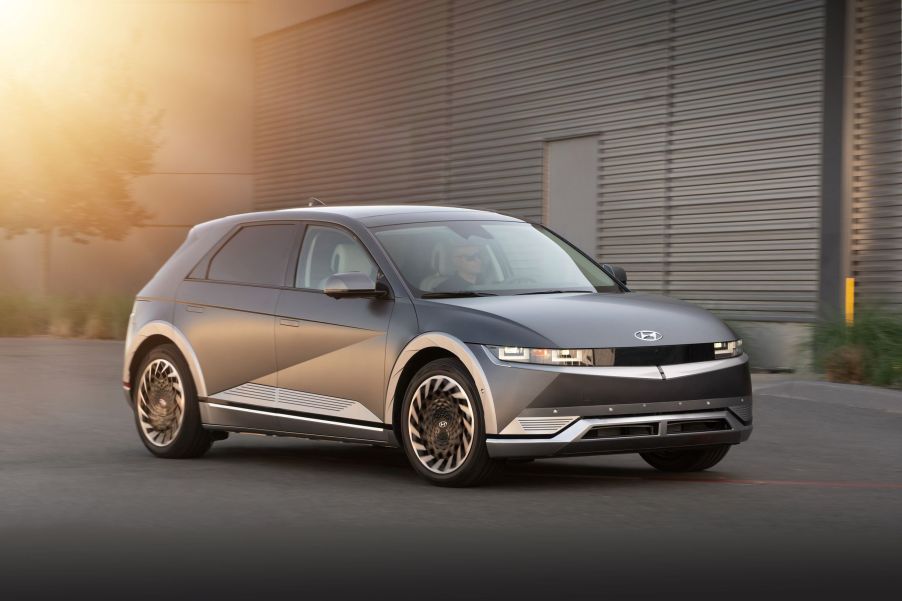
Does the 2022 Hyundai Ioniq 5 EV Really Have a 300-Mile Range?
Not only is it electrifying its rally cars, but Hyundai is also adding to its EV lineup in the US. Joining the Kona Electric and the Ioniq hatchback is the 2022 Hyundai Ioniq 5, an electric SUV, er, crossover. And among its features is a claimed 300-mile range. But is that achievable IRL?
The 2022 Hyundai Ioniq 5 EV comes to the US with power or range

While the standard Ioniq hatchback has a lot to offer, some potential buyers could get anxious from its 170-mile range. In that regard, the 2022 Hyundai Ioniq 5 is a significant improvement. However, getting the most range means giving up some performance.
In its base trim, the 2022 Ioniq 5 has a single rear-mounted electric motor and a 77.4-kWh battery pack. But buyers can add a second front-mounted motor, giving the EV AWD and more horsepower and torque. The standard RWD Hyundai Ioniq 5 has 225 hp and 258 lb-ft, The Drive reports. With the extra motor, though, that increases to 320 hp and 446 lb-ft, Roadshow reports.

The extra power and traction also come with greater performance. Hyundai claims an AWD Ioniq 5 goes 0-60 mph in under five seconds. But the downside is a smaller range, which also changes based on trim level.
In range-topping Limited AWD form, Hyundai claims the Ioniq 5 goes 244 miles on a charge. AWD SE and SEL models have a claimed 269-mile range. But for the truly range anxious, there’s the base Ioniq 5 with a 300-mile claimed range.
Will the Hyundai Ioniq 5 EV’s EPA range match its WLTP estimate?
There is a caveat to those range claims, though. For one, as of this writing, they haven’t been finalized by the EPA. Hyundai is “hoping” to see these range estimates, Car and Driver explains, but the final numbers aren’t in yet.
At least, they’re not available in the US yet. The Hyundai Ioniq 5 is currently available overseas with multiple battery pack options. In Europe, it’s available with a 52-kWh and a 72-kWh pack, Top Gear reports. It’s worth noting, though, that this doesn’t mean the US-spec EV’s 77.4-kWh pack only has a 72-kWh usable capacity. The two packs are separate entities, Roadshow reports.
Regardless, with the 72-kWh pack, the Euro-spec RWD Ioniq 5 has an estimated 290-mile range. This figure, though, is based on the European WLTP test cycle, which is often more generous than the EPA’s test. That’s likely because EPA procedures focus more on highway driving, whereas the WLTP cycle emphasizes urban driving, J.D. Power muses. With the latter, EVs make greater use of regenerative braking, thus decreasing overall power consumption.
It’s possible to ‘translate’ WLTP results to EPA estimates, but there’s no one established formula, InsideEVs explains. Plus, the US-spec Ioniq 5 has a larger battery than the Euro-market model, further complicating things.
However, let’s try anyway. According to the WLTP, the Ioniq hatchback goes 193 miles on a charge. Using the WLTP-estimated 290-mile range for the RWD Ioniq 5, and scaling linearly with battery size, that works out to an estimated 273 miles. But again, this is just a rough, back-of-the-envelope calculation.
How does the competition compare?
As of this writing, Hyundai hasn’t announced pricing details for the Ioniq 5. But the Korean automaker will start selling the EV “sometime this summer,” MotorTrend reports. However, Autoblog reports initial sales will be limited to the following states:
- Arizona
- California
- Connecticut
- Illinois
- Florida
- Georgia
- Maine
- Maryland
- Massachusetts
- New York
- New Jersey
- North Carolina
- Oregon
- Pennsylvania
- Rhode Island
- Texas
- Vermont

If the 2022 Hyundai Ioniq 5 meets its EPA targets, that puts it directly against the Ford Mustang Mach-E. Depending on the battery pack, Ford’s electric crossover manages 211-305 miles in EPA tests. However, the Mach-E has more power than the equivalent Ioniq 5.
There’s also the Volkswagen ID.4. In 201-hp RWD form, the VW electric crossover has an EPA-estimate range of 250 miles. And there’s an upcoming 295-hp AWD version based on the European ID.4 GTX. That model hasn’t been EPA tested yet, but it gets 298 miles on the WLTP cycle, MT reports.
Follow more updates from MotorBiscuit on our Facebook page.


